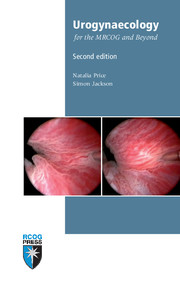Book contents
- Frontmatter
- Contents
- Preface
- Abbreviations
- 1 Applied anatomy and physiology of the lower urinary tract
- 2 Definition and prevalence of urinary incontinence
- 3 Initial assessment of lower urinary tract symptoms
- 4 Further investigation of lower urinary tract symptoms
- 5 Management of stress urinary incontinence
- 6 Management of overactive bladder syndrome
- 7 Recurrent urinary tract infection
- 8 Haematuria
- 9 Painful bladder syndrome and interstitial cystitis
- 10 Pregnancy and the renal tract
- 11 Ageing and urogenital symptoms
- 12 Fistulae and urinary tract injuries
- 13 Pelvic organ prolapse
- 14 Colorectal disorders
- 15 Obstetric anal sphincter injuries
- Index
13 - Pelvic organ prolapse
Published online by Cambridge University Press: 05 July 2014
- Frontmatter
- Contents
- Preface
- Abbreviations
- 1 Applied anatomy and physiology of the lower urinary tract
- 2 Definition and prevalence of urinary incontinence
- 3 Initial assessment of lower urinary tract symptoms
- 4 Further investigation of lower urinary tract symptoms
- 5 Management of stress urinary incontinence
- 6 Management of overactive bladder syndrome
- 7 Recurrent urinary tract infection
- 8 Haematuria
- 9 Painful bladder syndrome and interstitial cystitis
- 10 Pregnancy and the renal tract
- 11 Ageing and urogenital symptoms
- 12 Fistulae and urinary tract injuries
- 13 Pelvic organ prolapse
- 14 Colorectal disorders
- 15 Obstetric anal sphincter injuries
- Index
Summary
Applied anatomy of the pelvic floor
The pelvic floor consists of muscular and fascial structures that provide support to the pelvic viscera and the external openings of the vagina, urethra and rectum. The levator ani muscles that form the floor of the pelvis are attached to the bony pelvic walls and incorporate the perineal body of the perineum in the midline.
THREE LEVELS OF VAGINAL SUPPORT
The uterus and vagina are suspended from the pelvic side walls by endopelvic fascial attachments that support the vagina at three levels (Figures 13.1 and 13.2).
Level 1
The cervix and upper third of the vagina are supported by the cardinal (transverse cervical) and uterosacral ligaments. These suspend the cervix and upper vagina from the pelvic side wall and sacrum.
Level 2
The mid portion of the vagina is attached by fascia laterally to the arcus tendineus of the pelvic side wall.
Level 3
The lower third of the vagina is in direct contact with, and is supported by, the levator ani muscles and the perineal body.
Prevalence of pelvic organ prolapse
Pelvic organ prolapse, also called genital prolapse, is the descent of the pelvic organs into the vagina and is often accompanied by urinary, bowel and/or sexual symptoms.
- Type
- Chapter
- Information
- Urogynaecology for the MRCOG and Beyond , pp. 101 - 118Publisher: Cambridge University PressPrint publication year: 2012

